Forklift Trucks and their Use on Board Ships
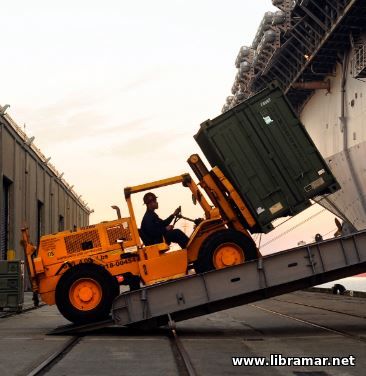
As we know, the forklift trucks are among the most useful and practical devices used on board ships. However, they shall be used with utmost care since they can be really dangerous to the people. The first thing is to assess the risk – a standard operating procedure for the use of forklift will have been produced as a result of the general risk assessment. This procedure should identify the hazards associated with operating the equipment on board particular vessel. It will also contain the control measures, such as the use of the correct personal protection equipment.
Only the qualified drivers shall be allowed to drive the truck. They shall have completed the appropriate training course conducted by the authorized organization. The certification they achieve shall be kept on boast as part of their personal records. Never use a forklift truck if you are not qualified to operate. And, prevent anyone from operating a forklift truck, who is not qualified or authorized to use it. Under no circumstances should you operate the forklift truck if you are taking prescribe medication affecting your ability to drive.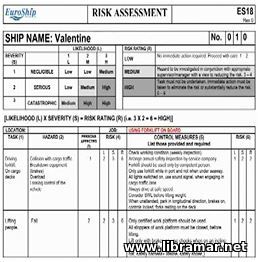
Likewise, anyone found driving under the influence of alcohol or illegal substances, is liable for immediate company dismissal and possibly criminal prosecution from port state authorities. In some instances, the work permit may be issued. This is good practice as it creates the record of the forklift truck use and the people who are authorized to drive it. The ignition key is then handed over. Note that they must be removed from the ignition each the forklift truck is left unattended or stowed.
A number of checks shall be made before the forklift truck is used. Firstly, we shall ensure the good working condition of the device. Ideally, there should be a condition checklist supplied based on the manufacturers guidelines, and the technical inspection should take a minimum of 5-10 minutes; that five or ten minutes of your time well worth taking – it will ensure the safety of yourself and your colleagues. These checks shall be made in the following order. Firstly, is the parking brake on? Next, the cage should be checked; where the open top cages are fitted, the hard hats must be worn as necessary.
It is recommended to always wear a hard had with the chin strap in place when operating the any forklift truck. The safety belt, if fitted, should be tested and inspected for wear – this must be worn at all times whilst driving the vehicle. Check the hydraulic connections for any leaks and wear-and-tear. The load guard, carriage plate, and forks should be inspected for signs of cracks or deficiencies. Oil and fuel levels must be checked. The oil level is correctly established by taking a dip stick reading. Coolant levels are checked and any relevant hoses inspected. There should also be sufficient fuel in the tank for the day’s operations. Wheels and tires are examined. Only now and upon completion of all checks, should the engine be started. If the engine fails to start, under no circumstances should the attempt be made to jump start the vehicle.
Once started, the foot brake can be tested. The steering should be checked for excessive play or wear. See and be 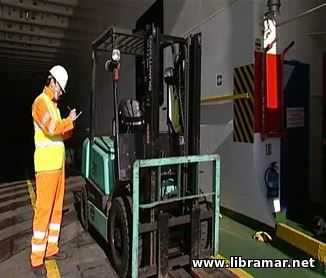 seen – vehicle lights and hazard lights must work efficiently and any mirrors positioned correctly by the driver. Be heard – check the horn and any reversing alarms. The hydraulic controls also need to function correctly. Finally, the tilt mechanism is tested. If any deficiencies are found, report must be made to the officer-in-charge and the key is returned, and “Do not use” sign must be displayed clearly so that the other crew members are aware of its condition. Remember, no matter how often it is used, each time the forklift truck is signed over, it must be checked prior to use.
seen – vehicle lights and hazard lights must work efficiently and any mirrors positioned correctly by the driver. Be heard – check the horn and any reversing alarms. The hydraulic controls also need to function correctly. Finally, the tilt mechanism is tested. If any deficiencies are found, report must be made to the officer-in-charge and the key is returned, and “Do not use” sign must be displayed clearly so that the other crew members are aware of its condition. Remember, no matter how often it is used, each time the forklift truck is signed over, it must be checked prior to use.
It must be established that the forklift truck is capable of lifting the load safely. At no time should you lift the load greater that than the vehicle’s specified Safe Working Load, which must be clearly marked. Care should be applied to the establishing the weight of the items to be lifted or moved. Large items, such as machinery or equipment, should also have their own weight indicated. Stores shall have their weight clearly described on the packaging or the delivery note. Never attempt combined lift with another vehicle. Complicated lifts involving a pair of forklifts requires special training and should not be carried out by ship’s personnel. Stores and supplies are usually delivered to the ship on pallets and these are ideally for maneuvering the loads around easily.
Whenever possible, put items on the pallets and secure them. The condition of the pallet must be checked for damage or defects before use. Items should be placed centrally on the pallet to maintain even balance. Larger pieces of equipment which are not suitable for palletizing, can be moved safely so long as they are secured and within the SWL of the equipment. Waste containers and the garbage bins are often moved by forklift trucks. Some of them are designed for this purpose; others are not and should be carried on a pallet. In some instances, forklift truck will be as the raised work platform – never use a pallet for this operation, only use specially designed, certified and approved 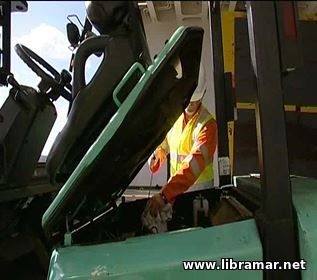 man carrying cages.
man carrying cages.
All working aloft procedures must also have an appropriate risk assessments carried out and permits issued prior to use. A forklift truck is not a taxi – under no circumstances should the cage be used to transport crew members. Particular attention must be given to how the forks interact with loads. Pallet sizes vary. The distance between the slots must correspond correctly with the forks. If not, the forks will need to be adjusted. Fork plates must be leveled and spaced equally apart, equidistant from the center to avoid a potentially dangerous unbalanced load. The load must also be checked for fork blade length. If the load exceeds the length of the forks, it could topple forward. If the load is significantly shorter that the fork length, the protruding blades must be taken into account, particularly if there are other pallets nearby. Remember – only lift items that can be moved or carried safely within the working limits.
It is vital that the fellow crew members, stevedores, visitors or anyone else in vicinity are aware of the forklift operations taking place. Extreme care should also be taken of passenger on vehicle ferries. Pedestrian walkways, emergency exits must remain clear. Ro-Ro loading and discharge involve a constant stream of traffic arriving and leaving the ship. Caution must be observed to avoid collision with the vehicles. Extra care must be taken if the load has to be reversed. If the load is large and obscures the vision of the driver, second crew member may be required to act as a signaler and to control the traffic flow, if necessary. Access to either the pickup point or drop off point should be checked for obstructions.
Overhead clearances shall be checked taking into account the height of the mast. The driving surface also needs to be taken into consideration. On uneven surfaces special care shall be taken. In addition, any wet or greasy surfaces must be approached with caution. Beware of loose items; they must not be driven over. Instead, they must be placed safely to one side, clear of the driving area. Finally, any ramps or inclines to be encountered on the traveling route also need to be taken into account; loads must be kept pointing uphill when traveling up or down the ramp or incline.
All personnel in the vicinity shall be informed that the operations are about to take place. Remember, as a qualified 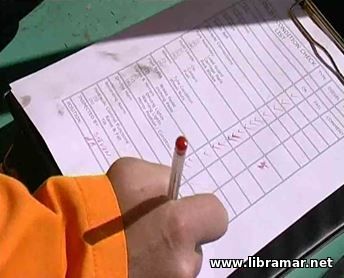 and responsible forklift truck driver you have an obligation to the safety of your fellow crew members. After putting on the seat belt, the engine is started and the flashing warning light is turned on. The forks are raised slightly and the mast tilted back to ensure sufficient ground clearance. Always start slowly and concentrate on where you are going and what you are doing. Slow down or stop when approaching coamings and use the horn when approaching traffic or personnel.
and responsible forklift truck driver you have an obligation to the safety of your fellow crew members. After putting on the seat belt, the engine is started and the flashing warning light is turned on. The forks are raised slightly and the mast tilted back to ensure sufficient ground clearance. Always start slowly and concentrate on where you are going and what you are doing. Slow down or stop when approaching coamings and use the horn when approaching traffic or personnel.
If you cannot be seen, be heard. Always use your mirrors. Inclines and ramps shall be approached straight on and do not make turns on ramps. Under no circumstances should you do U-turn on ramps. Always reduce speed when approaching corners or when making a turn. Steering uses the rear wheels; this makes the rear swing wide when turning. Also, because of the very short wheel base, the center of gravity is shifted upwards making the vehicle susceptible to toppling. Keep your whole body inside the truck whilst driving and never use mobile phones. Stay alert, stay aware and stay alive!
Approach any loads slowly and carefully with the mast in a vertical position. Apply the parking break. The forks should already have been adjusted for spacing. If not, they will need to be adjusted to avoid an uneven load distribution. Do not attempt to operate the lift controls from outside the cab as this is highly dangerous. If you cannot see get a signaler to help you. If the spacing is accurate, release the parking brake, keep the forks leveled and lined up just off the deck and insert them fully into the slots. Re-apply the parking brake and, with the truck in neutral, start lifting the load slowly, tilt the mast back, and stabilize the load.
With the load securely and safely distributed on the forks the break can be released and the load can be driven to its drop off point. At all times, when traveling, the load must be kept as low as possible and the mast tilted back. If the load size obscures forward vision, the forklift truck should be driven in reverse. When descending a ramp, the weight 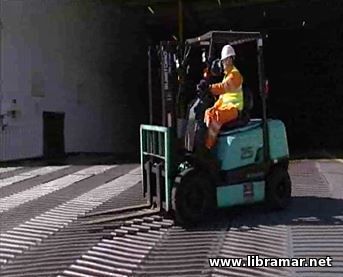 has to be kept uphill so you must only travel in reverse. Extra care must be taken whilst reversing, especially with wide loads. Always watch out for obstructions, people and stowed cargo.
has to be kept uphill so you must only travel in reverse. Extra care must be taken whilst reversing, especially with wide loads. Always watch out for obstructions, people and stowed cargo.
When putting the load on the deck, maneuver the forklift truck slowly into position at a right angle to the drop off area. Put the truck into neutral and apply the parking brake. Tilt the mast back to the vertical and then slowly lower the load. Check there is nothing behind you, release the parking brake, and reverse slowly without dragging the forks against the deck. Remember, the forklift truck is capable of turning very quickly in tight spaces. Never stand too close to a working forklift truck and n ever put yourself between a solid object and a maneuvering truck.
The "Read Later" function allows you to add material to this block with just one click. Just click on the icon and read the articles that interest you at any convenient time.


